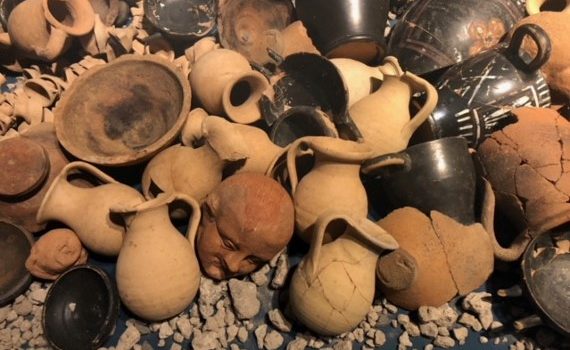In search of Stabia
“IN SEARCH OF STABIA””
The exhibition at the ANTIQUARIUM of POMPEII
Third Floor - From the 31st July 2018 to the 9th July 2019
“In Search of Stabia” is the title of an exhibition which will be inaugurated at the Antiquarium of Pompeii on the 31st July 2018, and will be on display until the 9th July 2019.
It will be a voyage of discovery through the history of Ancient Stabiae, using evidence left to us by the finds from the Necropolis of Madonna delle Grazie, with its numerous burials, as well as the connected extra-urban Sanctuary of Privati, with the votive offerings found there which were connected to women, and the protection of fertility and of giving birth.
Together they constitute two contexts of great importance in the reconstruction of the Stabian territory settlement dynamics, and for their importance in Pre-Roman times.
The Necropolis of Madonna delle Grazie
Between the end of the 7th and the beginning of the 6th century BC, deep transformations in territorial structures and settlement dynamics were triggered by the arrival of new peoples, such as the Etruscans. The populations of the most inland areas of the Sarno plan and the Monti Lattari stretched as far as the Gulf of Naples and opened up to new contacts. The necropolis of Madonna delle Grazie recounts this complex phase of transformation and offers us information on the inhabitants of the ancient centres which surrounded Pompeii.
Investigations have discovered around 300 tombs spread out over an area of around 15,000m2, which spanned a period from the second half of the 7th century BC until the end of the 3rd century BC; they are pit grave, stone coffin or tile-covered burials. The displayed objects outline the identity of the deceased and the adoption of wine consumption forms linked to the Greek and Etruscan world: ceramic blend, bucchero cups and goblets, as well as imported crockery, which was also imitated locally, indicating the social status of the deceased. There are also iron spits and andirons which indicate the cooking of meats, and clothing elements such as bronze fibulae and rings.
In later phases (5th - 4th centuries BC), plain vessels, black painted wares and, more rarely, red-figure vases prevailed, indicating social transformations and an adherence to new cultural models.
The Sanctuary of Privati
The Sanctuary of Privati spans a ledge of the Monti Lattari, which slopes panoramically towards the Gulf of Stabiae, and formerly marked the ancient boundary of Stabian territory, in a strategic position for controlling the routes connecting the Sarno Valley and the Sorrento-Amalfi area. The Sanctuary, beginning in the 4th century BC, was probably connected to women, and the watching over of fertility and births, as indicated by the terracottas with feminine images, as well as images of children and certain animals.
At the centre of the ledge was a large pit with votive elements, which were often intentionally broken before being deposited, mixed in with burnt earth and animal bones. The votive offerings were likely thrown away to make room for new offerings for the restructuring of the Sanctuary between the 2nd and 1st century BC. Ceramics predominate among the votives, with shapes linked to the ritual use of water and offering of liquids. Some kinds of statuettes, such as the figure of Athena with a Phrygian cap and Heracles, establish the Sanctuary of Privati as part of a network of places of worship which dotted the Sorrento peninsula, from the Doric Temple of Pompeii to the Athenaion of the Punta della Campanella.
Entrance to the exhibition is included in the access ticket to the excavations.
To see the video of the press conference click here


